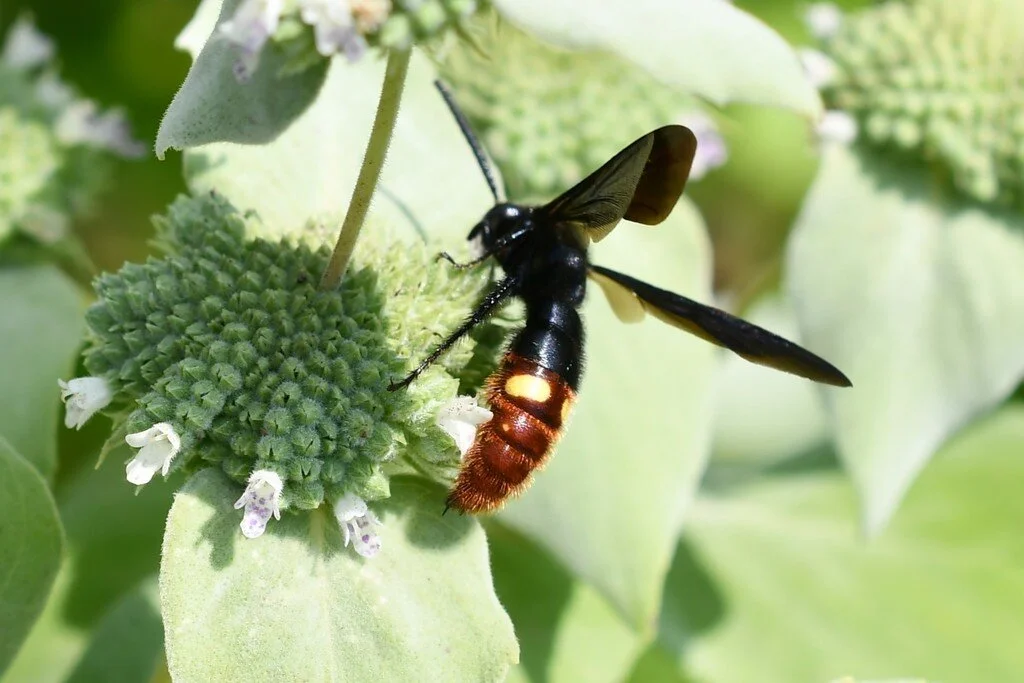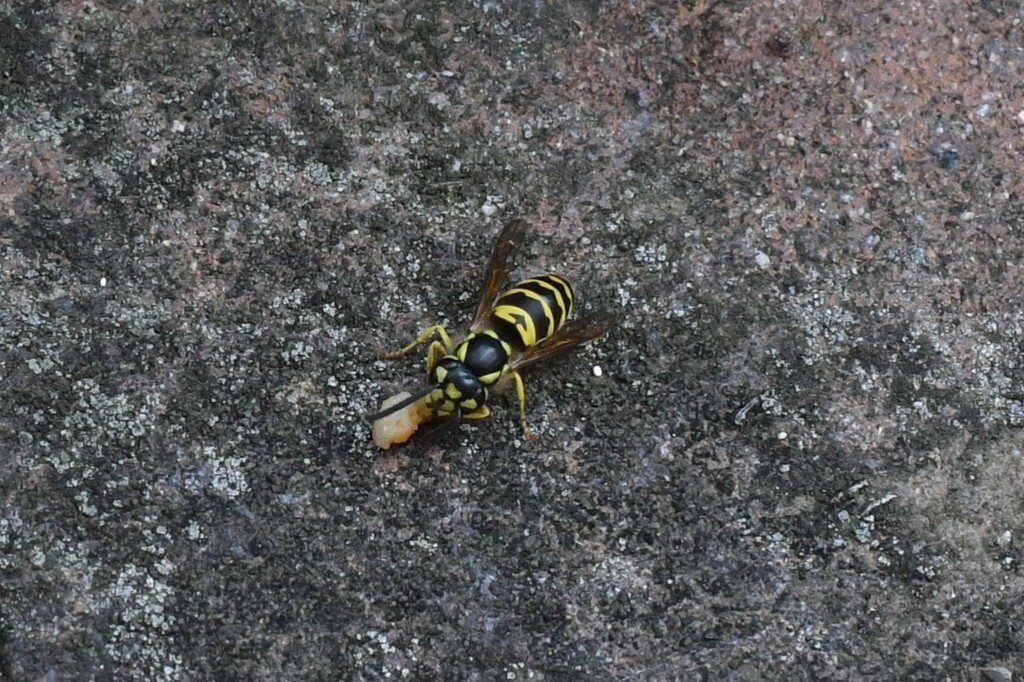Beyond Bees and Butterflies
Emily Ellis
We all know that bees and butterflies are important pollinators, but they are the tip of the iceberg when it comes to beneficial floral visitors. Many species of insects and other animals - some of them, such as lizards and small tree-climbing mammals, that you wouldn’t expect would sip on nectar or transfer pollen - are essential to the reproduction of the world’s plants.
Coneflowers and brown-eyed susans blooming in one of Rokeby’s pollinator plots.
In the Virginia area, our unexpected pollinators are mostly found in the form of insects - many of which nosh on common garden pests along with nectar and pollen, making them doubly welcome visitors. Such pollinators are an important part of healthy, biodiverse ecosystems, and at the Oak Spring Garden Foundation, we try to create welcoming environments for them by planting pollinator plots, as well as including plenty of pollinator-friendly native plants in our gardens and meadows.
In honor of National Wildlife Day this year, we’re celebrating some of the unsung - but no less important - pollinators that we see flitting and crawling among Oak Spring’s flowering plants. Scroll down to read more.
Hummingbird Moths
Is it a bird? A tiny, furry drone? No! It’s a clearwing, or hummingbird, moth - an especially whimsical insect that can be mistaken for a small hummingbird hovering among the flowers if seen at a distance.
A snowberry clearwing. Photo by Callie Broaddus.
Like their namesake bird, these moth species can remain suspended in the air in front of the flowers they sip nectar from. They have an especially long tongue that curls under their body, which allows them to sip from flowers that other pollinators can’t reach.
If you want to attract these charming pollinators to your garden, try planting tubular flowers like phlox and bee balm. Hummingbird moth caterpillars are hornworms (NOT to be confused with pesky tomato hornworms, which become hawk moths - see the difference here) and need specific host plants, including snowberry (the host plant for the snowberry clearwing - a commonly spotted hummingbird moth in Virginia), as well as several species of honeysuckle, dogbane, hawthorn, cherries, and plums.
Hummingbirds
Photo by Flickr user Rick from Alabama
The one non-insect pollinator on this list is everyone’s favorite floral visitor, the hummingbird. While there are about 2,000 species of pollinating birds worldwide, they are typically found in tropical areas; hummingbirds are the only ones we’ve got in the continental United States.
These tiny but mighty birds are important pollinators, as their long beaks can reach into flowers that other pollinators are unable to access. After sipping nectar, the pollen sticks on their foreheads or beaks, waiting to be transferred to the next flower. Since they have little to no sense of smell, they tend to be attracted to flashy reddish flowers; tubular, nectar-rich blooms including bee balm, trumpet vine, native honeysuckles, and lilies are all hummingbird favorites.
Here in Virginia, the ruby-throated hummingbird is found regularly throughout the summer during their breeding season, and you can occasionally spot the Calliope Hummingbird and the Rufous Hummingbird passing through in fall.
Wasps
You may want to think twice before you spray that wasp nest in your garden! Wasps are not only beneficial pollinators, but helpful predators of pests like grubs and unwanted caterpillars. While they are not quite as efficient at pollinating as bees are due to their lack of fuzzy hairs, they are still important floral visitors. Tiny fig wasps, for example, have an incredible relationship with the world’s fig trees, their life cycle taking place within the fruit they pollinate.
Beneficial wasps kill other insects by either parasitizing them or hunting them (in addition to sipping on fruits and flowers), and as as fall approaches and the fruit begins to drop from the orchards here at Oak Spring, we’re seeing a lot of them around. Here are just a handful of the beneficial wasp species we frequently spot at the Biocultural Conservation Farm and in the gardens:
Yellow Jackets
Photo by Michael Carr
They may buzz obnoxiously around your summer picnics - and most folks probably have at least one tale of having a painful encounter with a nest - but these vibrant, aggressive social wasps are pollinators as well as hunters of garden pests. While they do like to visit nectar-rich flowers (as anyone who has swatted one off a soda can won’t be surprised to learn), they are mostly useful in the garden in that they prey on pests like house fly larvae, grubs, and cabbage worms. While you probably don’t want them around if you’re allergic, it’s easy to coexist with yellow jackets by avoiding their underground nests, which can be spotted by the brightly-colored insects buzzing in and out of the hole.
blue-winged scoliid wasp
A blue-winged scollid wasp visiting mountain mint in the formal garden. Photo by Michael Carr.
Our farmers and gardeners have been seeing a number of these pretty parasitoid wasps buzzing around the crops and flowers this summer. They forage for nectar in flowers, and we have noticed that they are particular fans of the native blooms and herbs (especially dill) in the formal garden and in the Biocultural Conservation Farm’s pollinator strips. These digger wasps - which aren’t aggressive, unless you put your hand on one - are especially beneficial in that they parasitize pest beetles, including the despised June bugs and Japanese beetles.
Paper Wasps
Along with yellow jackets, paper wasps (so named because of the incredible hanging nests they build) are a pretty common sight in the summer and fall. Like the other wasp species on this list, they feed on plant nectar and are helpful pollinators, but are especially useful in that they are great vegetable protectors, aggressively hunting down garden pests such as cabbage worms and tomato hornworms (as seen in this video captured by BCCF manager of integrated pest management Nicke Sette). It’s worth noting that they’ll also eat beneficial butterfly caterpillars, however - no one’s perfect!
Paper wasps will defend their nests with just as much vigor as they’ll defend your crops from pests, so it’s best to keep a respectful distance from these insects.
Beetles
Photo by Melissa McMasters
Beetles are pollinators, too! And have been for a long time - fossil records have shown that beetles were among the first insects to visit flowers around 200 million years ago. Typically, flowers that are frequently pollinated by beetles are ancient species, such as magnolias.
While lady bugs are perhaps the most well-known friendly garden beetle due to their appetite for aphids, they also pollinate as they move from flower to flower. The especially like leafy plants with clusters of flat flowers that are easy to crawl across, including dill, yarrow, feverfew, and calendula.
Another frequently seen beetle pollinator is the margined soldier beetle: in the summer and early fall, it’s not uncommon to see several of these guys clinging to wildflowers like Queen Anne’s lace or goldenrod. While the adults are primarily nectar and pollen feeders, they will also munch on pests like aphids.
Flies
Photo by Flickr user Daniela
There are more than 110,000 fly species in the world. Some are inarguable pests (mosquitoes belong to the Order Diptera), and many are beneficial floral visitors. In fact, plant species such as the carrion flower develop a rotting scent to attract flies and other flesh-eating insects to pollinate them.
Easily mistaken for bees or wasps due to their expert mimicry, flower flies in particular are great helpers in the garden. Belonging to the family Syrphidae, flower flies can’t sting, but since they look like they can, they are often avoided by predators. Although their mouth parts vary among species, the typical flower fly mouth is essentially an extendible sponge that can mop up nectar or pollen, usually from flowers with a more open shape, such as asters. Their larvae also feast on aphid and other soft-bodied insect pests - an added bonus!
Thanks to gardener Michael Carr and BCCF Manager of Integrated Pest Management Nick Sette for their help with this blogpost!
Banner image by Michael Carr







